A day’s stalking while working as a volunteer pointed this assistant land manager towards the career path she now treads
Despite not growing up with a family connection to fieldsports, while working as a volunteer Megan Rowland became hooked on deerstalking. Now as an assistant land manager, she hopes to encourage and teach others.
For more sporting Dianas, seriously sporting ladies offering advice and encouragement, Rosie Whitaker learnt from a family of top shots and is passionate about encouraging the next generation into the field. And a hard hunting fall led Nicole Escue to a new-found passion for shooting.
MEGAN ROWLAND
My path into the world of land and wildlife management has been a meandering one.
Unlike many in the sector, for whom it has been part of life from day one, I didn’t grow up with any family connection to hunting, shooting or fishing at all. Although I’m assured my grandfather was a keen shot, we never met.
In fact, by the time I was born both my parents were vegetarians, due to an incident with some overcooked lamb several years previous. Although, ironically, it was lamb that also switched them back to eating meat after more than 20 years, when they began keeping their own rare breed flock.
I spent the first part of my life on a croft on the mainland of Orkney, a good place to grow up if you’re keen on the outdoors. Intending to head into a conservation career upon leaving school I began a bachelor’s degree in environmental science. About 18 months in I realised the fit wasn’t quite right and decided on a different route.

Megan is about to begin her fourth season on placement at an estate in Sutherland.
I had become increasingly interested in taxidermy, ‘vulture culture’, and discussions on ethics. Tying this into my parents’ foray into farming I also began to reconsider my diet. The Damascene moment came when looking at a leg of mutton – from a sheep reared, slaughtered, butchered and eaten right on the croft. I decided to adopt what is now known as a ‘locavore’ or ‘flexitarian’ ethic – eating meat that I, family or friends had reared.
By this point, I had relocated and moved south to the Highlands. Deciding there was no point entering academia until I had found a direction I wanted to travel in, I began volunteering with various charities (whilst holding down awful day jobs). I spent nearly three years with RSPB Scotland. Following this, I assisted in the baseline surveys at the Game & Wildlife Conservation Trust study farm at Auchnerran, and spent several months working between east and west coast with the Scottish Wildlife Trust on the Coigach & Assynt Living Landscape project.
These were all fascinating experiences, teaching me a great deal and helping shape a lot of my thinking on integrated land use; though it may surprise readers to discover that it was my time with RSPB Scotland that put me on the path I’m on. Heading out one morning to carry out some surveys, my colleague and I passed a group of stags. I remarked that I would like to have a go at deerstalking, firmly believing (as I still do) that if you eat meat you should see the process through from start to finish at least once. He said he would see what he could do.

Having not come from a fieldsports family, she hopes to make the path in to stalking easier for anyone new.
Sometime prior to this I had joined my local rifle range (shout out to Tain Rifle & Pistol Club), something I highly recommend for those starting out, and even for those who claim a bit more experience. It’s a good way to mix and be sociable but also an excellent way to get back to the basics of rifle work. I spent a lot of time shooting a .22 with iron sights, learning to control my breathing and trigger discipline – now, when I take out clients, the first thing I notice on the target is someone snatching and ‘pulling’ the trigger. This practice all proved worthwhile when my colleague sent me a message asking if I wanted to go stalking and, after a long day, I shot my first deer.
The experience of my first stalk changed my outlook completely. It is cliché but I was taken aback by how clean the process was, how small a part in the day the actual shot took, how quickly the beast went from field to food chain, and the insight into the deer and their place in the landscape. I realised I was hooked and wanted to learn more.
I began beating and picking up on small and large shoots, had a go at wildfowling and worked for a season as an underkeeper on a pheasant shoot in Perthshire. However, I quickly realised deer and their management was where my interest lay. I duly signed up for the North Highland College’s Game with Wildlife Management course and spent the next two years on placement on an estate in Sutherland, where I’m about to begin my fourth season stalking with clients.
I’m extremely fortunate to do what I do; hunting at home and abroad, meeting people from all over the world, and working with deer. I am also particularly keen now to teach others and make the path for anyone new a little easier.
TOP TIPS: Don’t overgun yourself. Learn to shoot well with a small-bore rifle, such as a .22, and the rest will follow. If you recognise you’re flinching or snatching the trigger – go back to basics. Never get separated from your lunch.





